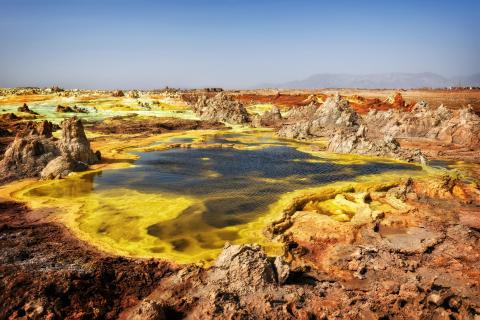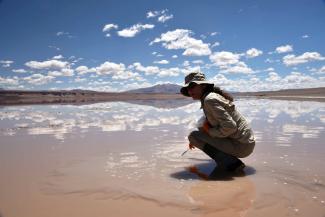
Puri López-García: a naturalist from the microbial world in search of life's origins
Puri López-García is a researcher in biology and CNRS Director of Research at the Ecology, Systematics and Evolution Unit (ESE - Univ. Paris-Saclay/National Centre for Scientific Research, CNRS/AgroParisTech). A specialist in microorganisms, including archaea, bacteria and microbial eukaryotes, she uses the study of the invisible world to trace the history of life on Earth and shed light on the major evolutionary transitions that have shaped our planet. She is also a member of the French Académie des Sciences, the Royal Academy of Belgium and the American Academy of Microbiology.
Born in Madrid, Spain, Puri López-García's developed a deep passion for nature and animals at an early age, which led her to study biology. At university, she was first introduced to the world of plants, and then to that of microorganisms. "I was immediately fascinated by this invisible world. It made me want to understand ecosystems in their entirety, including all forms of life, even the smallest," recalls the researcher. Already captivated by the questions of evolution and the origins of life, she initially enrolled in anthropology, but soon realised that her true interest lay in the microbial world. She decided to specialise in marine biology and went on to study at the University of La Laguna, in the Canary Islands. "For two years, I discovered oceanography and plankton biology, and carried out my first small research project," she says. It was an experience that opened up a universe teeming with life - that of invisible yet essential marine organisms - and confirmed her desire to pursue a career in research.
A starting point: the discovery of archaea
During her PhD at the Autonomous University of Madrid, Puri López-García joined a laboratory based in a highly regarded molecular biology centre. There, she began studying halophilic archaea, particularly the species Haloferax mediterranei, a microorganism that lives in highly saline environments. She decided to conduct her thesis on the physical organisation of this archaeon's genome. She discovered that Haloferax had a circular chromosome and three megaplasmids, a genomic structure that was still relatively little-known at the time. "At that point, genome sequencing wasn't yet widespread, so I used techniques such as hybridisation with phosphorus-32-labelled radioactive DNA fragments and pulsed-field gel electrophoresis to create a physical map of the genome," explains the researcher. From early on, she decided to focus her research on the evolution of life forms and the extreme environments in which they thrive.
The syntrophy hypothesis
She went on to complete a post-doctorate at Université Paris-Sud (now Université Paris-Saclay), where she worked on DNA topology in hyperthermophilic archaea. "My research into high-temperature adaptations led me to explore how the first cells may have emerged and evolved," she explains. Alongside her colleague David Moreira, she developed the syntrophy hypothesis, a model according to which the eukaryotic cell evolved from a three-way symbiosis: an archaeon, a host bacterium and an alpha-proteobacterium (ancestor of the mitochondrion). Though considered bold at the time, the theory has gained renewed attention following the discovery of the Asgard archaea, a group closely related to eukaryotes.
A decisive shift: exploring microbial diversity in deep-sea environments
On her return to Spain, she joined Miguel Hernández University in Alicante, and began exploring the microbial diversity of deep-sea environments, using molecular biology techniques. "Together with David Moreira, we identified unknown archaeal lineages and discovered an unsuspected diversity of eukaryotic microorganisms in the deep ocean," explains the researcher. Her results were published in Nature, paving the way for a new exploration of the invisible living world.
Return to France and establishing a team at the CNRS
In 2002, she joined the CNRS as a research fellow. Alongside David Moreira, she founded the Diversity, Ecology and Evolution of Microbes (DEEM) team at Orsay, within the Ecology, Systematics and Evolution Unit (ESE - Univ. Paris-Saclay/CNRS/AgroParisTech). "Our research has focused on investigating microbial diversity and the ecology of little-explored environments, in order to address fundamental questions about the origin of life, its diversification and major evolutionary transitions," she explains. Her approach combines field expeditions to understand the ecology of organisms in their, often extreme, environments, with advanced metagenomic and phylogenetic analyses to reconstruct their evolutionary history.
Expeditions and extreme environments: at the frontiers of life
Throughout her career, she has organised and participated in many scientific expeditions across a wide range of extreme environments, such as volcanic lakes in Mexico, hydrothermal springs, abysses, the Chilean Andes, Dallol and the Danakil Depression in Ethiopia. "These field sites are an opportunity for me to observe life under extreme conditions, to study its physical-chemical limits and to gain insights into how it adapts. In the Danakil Depression, we have identified locations where life is absent despite the presence of surface liquid water. This demonstrates that certain environments containing liquid water - a classic criterion for habitability - can nonetheless be sterile." A crucial discovery for astrobiology.
Interdisciplinarity: a key to new discoveries
Puri López-García's research is inherently interdisciplinary, regularly involving discussions with theorists, chemists, physicists, astrophysicists and geologists about fundamental questions such as the origin of life and habitability. She is a prominent figure in the field of astrobiology, where her research into life in extreme environments helps shape our understanding of the potential for life elsewhere in the universe. Her studies of cyanobacteria, in particular Gloeomargarita lithophora, have shed a unique light on the origin of photosynthesis in eukaryotes. "The ancestor of the chloroplast was closely related to Gloeomargaritales, a recently identified group of freshwater cyanobacteria found in thermophilic mats and microbialites. This suggests that eukaryotic photosynthesis may have evolved on land and not in the oceans, as is commonly believed," notes the researcher.
Microbial diversity and global challenges
By exploring the immense and largely unknown world of microbial diversity, the work of Puri Lόpez Garcia and her team not only takes us back in time, but also highlights its fundamental role for our planet. "Microorganisms are central to Earth's major biochemical cycles: oxygen production, carbon and nitrogen recycling, methane generation, etc. To overlook their role is to miss a key lever in the fight against climate change." Puri López-García therefore advocates for this invisible biodiversity to be recognised in environmental policies and integrated into sustainability models. For the researcher, "exploring microbial diversity also means uncovering solutions to our major global challenges."


